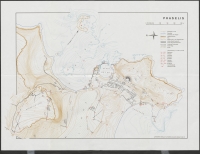
Right or left click with your mouse to enlage.
| For the photo's, see below |
| Home / the complete website |
 |
|
Very detailed map (30 Mb) of Phaselis (Turkey) (Schafer 1981). Right or left click with your mouse to enlage. |
| Item | Info |
|---|---|
| Length | 0,45 km |
| Cross-section | Pipe diameter 0,085 m |
| Volume | ?? m3/day |
| Gradient | 0,22 % |
| Period | unknown |
| Features |
|
| Recommended literature : |
|
| Recommended websites : | |
| How to visit : | Take the main road south of Antalya. After about 50 km (a few kilometers after Kemer) there is a well-signposted road to the left. After 300 m one has to buy a ticket. Follow the main road towards the (northern) harbor of ancient Phaselis. |
| HOME | More literature on more aqueducts | Last modified: December 2014 - (webmaster) |